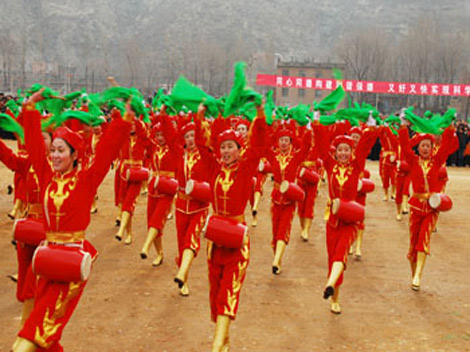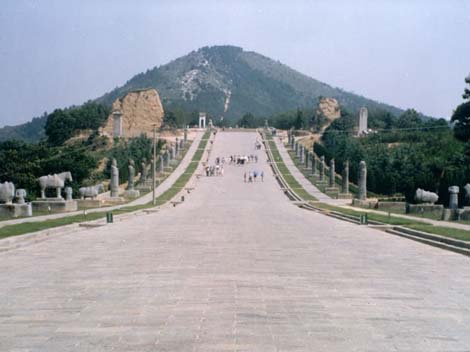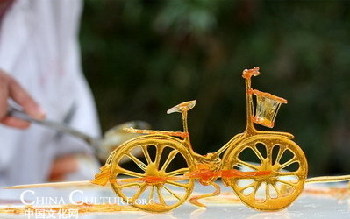| Home > China Feature |
Battle of Changsha 1944
The Battle of Changsha (1944), (also known as the Battle of Hengyang or Campaign of Changsha-Hengyang) was an invasion of the Chinese province of Hunan by Japanese troops near the end of the Second Sino-Japanese War. As such, it encompasses three separate conflicts: an invasion of the city of Changsha and two invasions of Hengyang.
The Japanese military transferred the bulk of their troops from Japanese homeland and Manchuria as part of Operation "Ichi-Go" or "Tairiku Datsu Sakusen" which roughly translates as 'Operation to Break through the Continent'. This was an attempt to establish a land and rail corridor from between the Japanese occupied territories of Manchuria, Northern and Central China and Korea and those in South East Asia. In June 1944 the Japanese deployed 360,000 troops (not including air or sea support) to invade Changsha for the fourth time (the first being in 1939). The Operation involved more Japanese troops than any other campaign in the Second Sino-Japanese war.
Battle of Changsha
On 27th May, 1944, the Japanese 11th Army launched the 1944 general offensive toward Changsha as scheduled.
The Japanese modified the tactics they had used in their previous three attempts by using the crack 3rd and 13th Divisions to attack Wanyang mountain toward Liuyang, effectively flanking the Chinese troops defending Changsha and cutting off their possible retreat routes, and placed some secondary divisions in charge of attacking Changsha. The Chinese attempted to use the previous tactic of avoid direct contact by marching in parallel fashion to flank the Japanese, but were unable to encircle the enemy like before and had to retreat. This allowed IJA to rapidly ransack the city of Changsha, breaking the defenses of the infantry within the city, as well as neutralizing the Chinese artillery on Yuelu Mountain, and Changsha was quickly lost to the Japanese.
A two-star general Zhang De-neng, the commander of the NRA 4th Corps in charge of defending Changsha, ordered a general retreat against a direct order telegrammed from his immediate superior, Xue Yue (薛岳), the Commander of the ninth Military Front. However, Zhang did not provide a feasible plan and fled the city while leaving most of his troop withdrawing in confusion and to be taken prisoner by the Japanese. Zhang was arrested by Xue, trialled and sentenced by a court-martial for a five-year imprisonment, and later ordered executed by Chiang Kai-shek on the charge of "incompetence of command and desertion upon combat engagement" by the power of "Military Discipline upon Combat Engagement."(战时军律)
Battle of Hengyang
Two Japanese military detachments moved on to besiege Hengyang, but the Chinese National Revolutionary Army's understrength Tenth Corps under the command of Fang Xianjue repelled their advance twice. The predicament in Hengyang helped hasten the crumbling of the Tojo Hideki's cabinet. In conjunction of the lose of Saipan on 9th July 1944, Tojo Hideki and his cabinet handed in their resignation on 18th July 1944.
In August 1944, Japanese troops led by three two-star generals again attacked Hengyang with air support. Chinese troops resisted fiercely aided by local knowledge, and constructing effective barricades up to 4-meter high. The Chinese defenses were intelligently constructed and used crossfire zones to maximize firepower. This caused the Japanese 68th and 116th Divisions to lose morale and it began preparations for retreat. Morale rose, however, when the Japanese 58th Division broke into the northwest perimeter of the city, defended by the Chinese Third Division, and the attack resumed. Reinforcements from five Corps of 62nd, 74th, 79th, 100th, and 37th sent by the Chinese National Revolutionary Army attempted many times to reach Hengyang, but were blocked by four Japanese divisions of 27th, 34th, 40th, and 64th.
The Japanese eventually captured the Chinese Tenth Corps commander Fang Xianjue, who surrendered Hengyang to the Japanese on 8 August 1944 after his Tenth Corps was decimated from seventeen thousands down to three thousands of wounded men. This concluded the Campaign of Changsha-Hengyang.
The defeated Tenth Corps
Chinese National Military Council reactivated the headquarter of the Tenth Corps at Yi-San in Guangxi after the defeat of Hengyang. They assigned the previous Corps commander Li Yu-tang back in charge. Li Yu-tang was the commanding general of the parent unit of the Tenth Corps.
Some of the surviving Tenth Corps soldiers slipped through the Japanese encircled lines and returned to the new corps headquarter on foot.
Among the imprisoned three thousand wounded Chinese soldiers, one thousand died of starvation, injury, sickness or mistreatment from the Japanese.
Most of the captured Chinese general officers at Hengyang managed to break through Japanese imprisonments, separately. On 19th, September 1944, Fang Xianjue was later rescued by a clandestine team from Changsha Station of the Chinese "Military-Statistics Bureau" of National Military Council, and personally received by Chiang Kai-shek at Chiang's Chungking residence on 14th December, 1944. Against the unofficial military traditions in east Asia, "Fang and his five tiger-like generals," all six general officers of the surrendered Chinese Tenth Corps were in Chungking awarded the Order of Blue Sky and White Sun. Fang and the other two generals were given the solid commands of a new full-strength division. At the same time, Fang was also assigned to the two-star deputy commander of the 37th Army Group. All six general officers remained in active military duty until the end of war and further on.
Aftermath
After 47 days of bitter fighting, the Japanese troops managed to occupy Hengyang with a high price in casualties over the city of Hengyang: many lives were lost, including 390 Japanese commissioned officers dead and another 520 wounded. The 68th and 116th Divisions lost their combat strength and were reassigned to garrison duties. Thus, the Chinese troops to the north were able to expand their influence despite the loss of Hengyang city. This was also the only battle where Japanese casualties was higher than the Chinese during the entire war.
Sequentially, the Japanese 11th Army moved toward Lingling, seized it on 4 September 1944, and controlled Guilin on 10 November 1944.
The Japanese China Expeditionary Army ostensibly had completed the strategic objective of the Imperial Japanese General Staff: to form a land pass linked up their occupation territories in east Asia, although they did not have enough manpower to maintain actual control over it due to their heavy losses.
Moreover, the United States Army Air Forces transferred all their bomber groups in the above Chinese air bases to their newly captured Saipan in July 1944, during the battle of Hengyang. From Saipan, United States aerial fleets started their bombing campaign against the home islands of Japan. One of the Japanese tactical achievement in this bloody Operation Ichi-Go had been easily neutralized by a simple but also bloody American military maneuver in the Pacific.
After the battle of Hengyang, the Japanese could not continue to fight effectively. During this period Japan discovered that government privileges from Wang Jingwei's puppet regime were useless, and consequently they rejected plans to take more Chinese territory. At the same time their negotiating position with China became significantly less powerful -- to the point where they agreed to set aside the "Tang Ju" treaty.
The Chinese government continued to pressure the Japanese to completely withdraw from the northeast. The Japanese, in a desperate measure, collected as many troops as possible in April 1945 to invade a heavy settlement Zhijiang in the west of Hunan, hoping to open a path to Sichuan. The troops were intercepted in an ambush by the Chinese National Guard and were almost completely wiped out, and China regained some of its territory. By this point, the course of the war had turned. Later, the Japanese surrendered at the Zijiang River.
Art
 more
moreYicheng Hua Gu
The Flower Drum 花鼓 of southern Shanxi Province is a kind of folk d...

Sculpture in Qianling Mausoleum
The sculpture of Qianling Mausoleum is the main relic of the ground ...

A Sweet Art:Sugar Painting
In and around China’s southwestern Sichuan Province, it is usual to ...

Custom
 more
moreWeb Dictionary
Martial Arts
Bruce Lee
There’s a new biopic of martial arts expert Bruce Lee ahead of us....
Wudang Martial Arts
Wudang Wushu is one of the key schools of Chinese martial arts. ...
Wuxia, a Popular Culture for Most Chinese-Speaki...
Wuxia (武侠) is a broad genre of Chinese fiction that concerns its...





 print
print  email
email  Favorite
Favorite  Transtlate
Transtlate 







